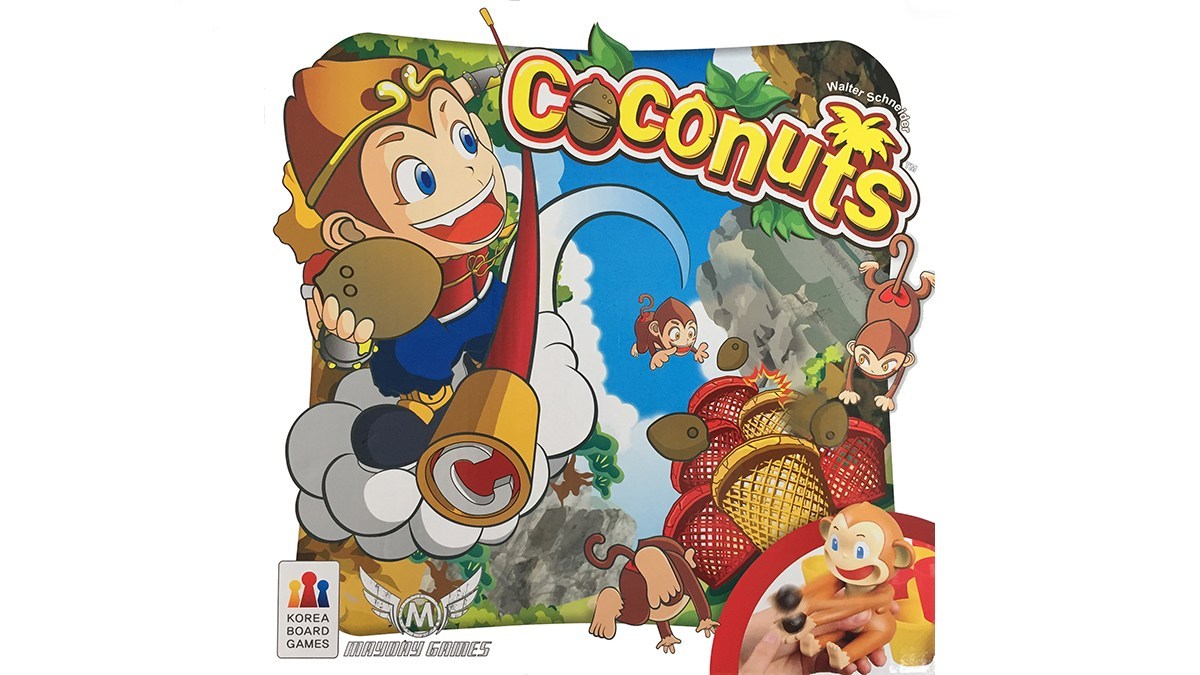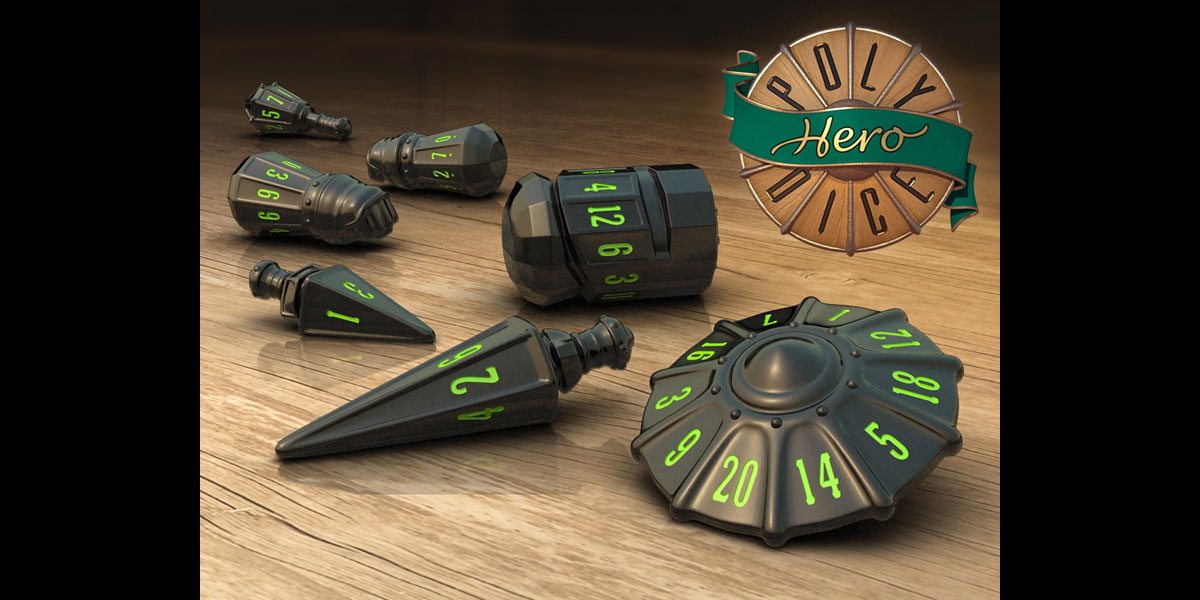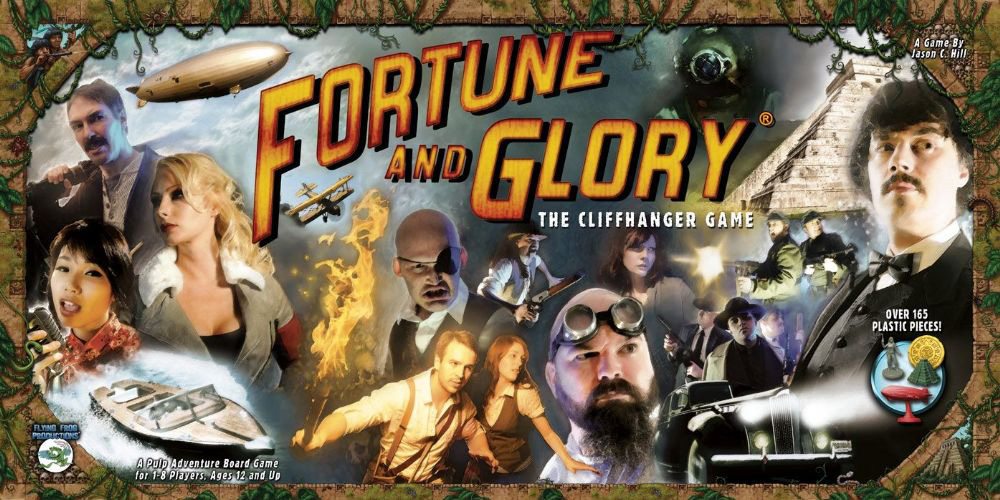In Coconuts, you literally get to monkey around. In this kid’s game, take turns flinging your coconuts into cups. Be the first to capture six cups and you are the winner!
What Is Coconuts?
Coconuts is a lighthearted dexterity game for 2-4 players that plays in approximately 15-30 minutes. While the recommended age is 6+, my 4 year-old has played, giggling the whole time. It is designed by Walter Schneider and is available from the publisher, Mayday Games, for $25.00.
Coconuts Components

Since Coconuts is a simple dexterity game targeted at kids, there are not a lot of components. However, there is a ton of fun packed into this game! Here’s what comes in the box:
- 4 Monkey Launchers
- 4 Player Boards
- 14 Cups (4 red, 10 yellow)
- 36 Coconuts
- 12 Magic Cards
The first thing that you will want to do after opening the box is play with the monkeys. These cute little guys are essentially catapults. While holding down their feet, you place a coconut in their little hands, pull down their arms, and let fly! These would be fun to play with even without a game to go along with them. They feel more like a toy than a game component, which is why kids are immediately drawn to them. Because this is a kid’s game, durability is an important factor and they don’t disappoint. After a year of use and abuse by me and my kids, the monkeys still function like new and I have never had a problem with them.
The coconuts look like chocolate covered almonds, not quite spherical, which makes them bounce in different directions, like tiny footballs. They are soft and rubbery and their tactile nature makes you want to handle them. The only issue I have had with them is not mistaking them for candy. Every time we play, my daughter mentions that she wants to eat them. There are versions of the game that include green and pink coconuts, but it doesn’t add anything new to the game play. It just makes them easier to find when they bounce onto the floor and less likely that you will try to eat one!
The cups are plastic and solidly made. In fact, they could easily be used as actual cups in a pinch if you ever needed to quench the thirst of a pack of parched four-year-olds. As for the player boards and cards, they are manufactured with standard card stock. Not thick, but with fun artwork and a smooth shiny finish to them.
How to Play Coconuts
Setup
As you might have guessed, setup for Coconuts is simple. Each player takes a player board, a monkey launcher, 8 coconuts, and 2 magic cards. Depending on the number of players, the boards are arranged in either a square (2 or 4 player game) or triangle (3 player game) pattern. The 4 red cups are stacked below yellow ones as shown below and in a 2 or 4 player game, the extra yellow cup is stacked in the center. Setup takes just a couple of minutes and then you are ready to begin.

Play
Beginning with the youngest player, each person will shoot a coconut from anywhere behind the red line on their player board, trying to land it in a cup. If successful, that player takes that cup and places it on their player board. The goal is to be the first person to create a six-cup pyramid. If you get a coconut into a red cup, you immediately get another shot. Otherwise, play moves to the left.
If a player runs out of coconuts, just grab a loose one from anywhere on the board, but don’t remove any that are already in cups. Once a coconut is in a cup, it stays in a cup.
One important rule to note is that you can steal cups from other players if your coconut lands in a cup they have already claimed. This is an important strategy when someone is close to completing their pyramid. And it’s okay to have multiple coconuts in a single cup.

Lastly, at the beginning of a turn, any player may play a magic card. The magic cards have different effects, including forcing a player to shoot with their eyes closed, or giving a player two shots on their turn. Five out of the six effects cause another player to perform a more difficult shot, adding a bit of “take that” to the game. Depending on the ages or personalities of the players, you can choose to play without these cards.

End Game
The first player to complete their six-cup pyramid is declared the winner. If as a group, all the coconuts have successfully found homes in the cups, but no one has built a pyramid, the player who has the most coconuts in the cups on their player board takes the crown. If there is a tie, the player who shot lasts wins.

Why You Should Play Coconuts
Why? Because you get to fling rubber coconuts at other players… I mean into cups. This reason alone is worth the price of admission. Coconuts is a quick, fun game that has everyone at the table laughing and enjoying themselves. Also, this game is an age equalizer. No matter if you are 4, 40, or 400 years old, anyone has an equal chance at winning. The coconuts never seem to fly exactly where you expect them to and they often take odd bounces out of and into cups you weren’t even aiming at. As a parent of a four- and eight-year-old, Coconuts is currently the one game I own that all three of us can play and enjoy. It’s easy enough for my four-year old while still being fun and competitive for my eldest child and me.
For me it is reminiscent of childhood games like Torpedo Run, where pieces are flying everywhere and everyone is having a good time. In fact, we always play the game on the floor and I would recommend you do also. First, it is inevitable that the coconuts will fall off the table, sending players out of their chairs and scrabbling around on the floor after them. So why not start there? And secondly, it provides more space to adjust how far or close we want to be to the cups. Playing on a table will limit the placement of your monkey whereas being on the floor allows for ample space to test your range. Lastly, while the Magic Cards do add another layer to the game, they aren’t necessary. If you want to add a bit more challenge or “take that” feel to the game, then they will accomplish that. But if you just want to having fun, monkeying around, leave them out. Either way, Coconuts is one game that will stay in my collection, even after my kids grow up.
![]() To subscribe to GeekDad’s tabletop gaming coverage, please copy this link and add it to your RSS reader.
To subscribe to GeekDad’s tabletop gaming coverage, please copy this link and add it to your RSS reader.





